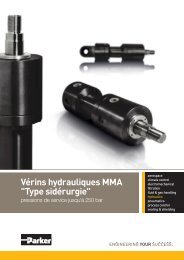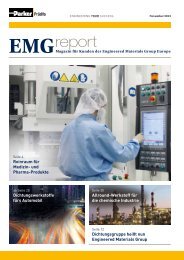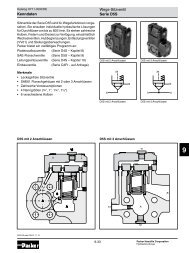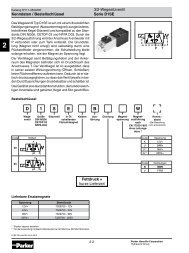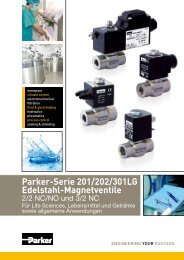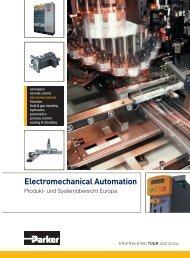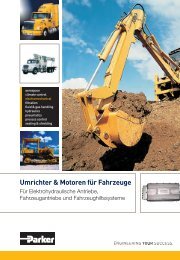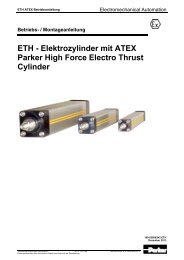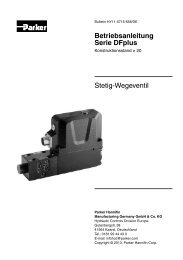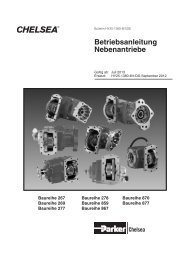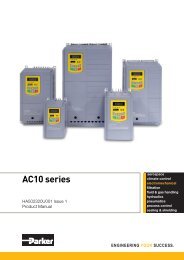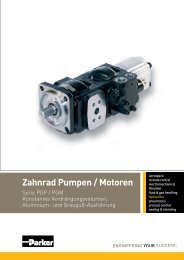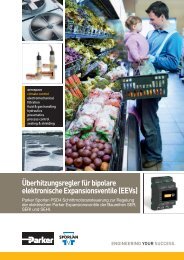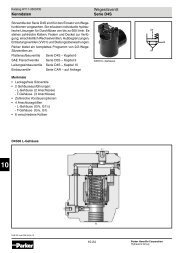L50 Injection Lubricator - Parker
L50 Injection Lubricator - Parker
L50 Injection Lubricator - Parker
You also want an ePaper? Increase the reach of your titles
YUMPU automatically turns print PDFs into web optimized ePapers that Google loves.
2" Basic <strong>Lubricator</strong> (3 Quart Capacity) 1L801B<br />
FILL PLUG<br />
KIT<br />
CHECK<br />
VALVE<br />
FLOW-GUIDE ®<br />
VARIABLE<br />
ORIFICE KIT<br />
(Includes Screw<br />
and Washer)<br />
GASKET<br />
TANK<br />
NNR<br />
PETCOCK<br />
NNR = NOT NORMALLY REPLACED<br />
Maintenance Procedures<br />
SIGHT DOME<br />
KIT<br />
SCREW<br />
(6 Required)<br />
BODY<br />
NNR<br />
BALL<br />
ADAPTER<br />
SIPHON TUBE<br />
ASSEMBLY<br />
SIPHON TUBE<br />
INLET FILTER<br />
SIGHT GAUGE<br />
KIT<br />
1. Given clean operating conditions, this unit should be<br />
trouble-free. Contaminants from dirty oil may collect on the<br />
siphon tube inlet filter, requiring the filter to be cleaned by<br />
tapping on a hard surface and blowing off with an air<br />
blow gun.<br />
2. IF THE OIL DELIVERY RATE DROPS, the lubricator should<br />
be cleaned. Shut off the air supply and reduce the pressure<br />
in the unit to zero. Remove the adjusting screw and clean<br />
the needle and seat in the body. Inspect and clean the<br />
passage from the needle seat down into the siphon tube<br />
adapter. Remove the Flow-Guide ® variable orifice screw<br />
and clean air passages with a small wire. Check the bore<br />
that the screw fits into for contaminants and clean if<br />
necessary. Be sure the passageway from the sight dome<br />
cavity downward is open. Remove and clean the valve seat<br />
and the valve bracket.<br />
3. Drain off any contaminants which collect in the bottom of<br />
the tank.<br />
Kits and Parts Available<br />
Kit No. Description<br />
PS608 O-Ring Repair Kit<br />
PS615 Siphon Tube Assembly Kit<br />
PS610 Fill Plug Kit<br />
PS611 Flow-Guide ® Variable Orifice Kit<br />
PS613 Sight Dome Kit<br />
PS616 Sight Gauge Kit<br />
Certain compressor oils, chemicals, household cleaners, solvents, paints<br />
and fumes will attack plastic bowls and can cause bowl failure. Do not<br />
use near these materials. When bowl becomes dirty replace bowl or<br />
wipe only with a clean, dry cloth. Reinstall metal bowl guard or buy and<br />
install a metal bowl guard. Immediately replace any crazed, cracked,<br />
damaged or deteriorated plastic bowl with a metal bowl or a new plastic<br />
bowl and a metal bowl guard.<br />
SOME OF THE MATERIALS THAT WILL ATTACK<br />
POLYCARBONATE PLASTIC BOWLS<br />
Acetaldehyde Chlorovenzene Methylene chloride<br />
Acetic acid (conc.) Chloroform Methylene salicylate<br />
Acetone Cresol Milk of lime (CaOH)<br />
Acrylonitrile Cyclohexanol Nitric acid (conc.)<br />
Ammonia Cyclohexanone Nitrobenzene<br />
Ammonium fluoride Cyclohexene Nitrocellulose lacquer<br />
Ammonium hydroxide Dimethyl formamide Phenol<br />
Ammonium sulfide Dioxane Phosphorous hydroxy<br />
chloride<br />
Anaerobic adhesives Ethane tetrachloride Phosphorous trichloride<br />
& sealants Ethyl acetate Propionic acid<br />
Antifreeze Ethyl ether Pyridine<br />
Benzene Ethylamine Sodium hydroxide<br />
Benzoic acid Ethylene chlorohydrin Sodium sulfide<br />
Benzyl alcohol Ethylene dichloride Styrene<br />
Brake fluids Ethylene glycol Sulfuric acid (conc.)<br />
Bromobenzene Formic acid (conc.) Sulphural chloride<br />
Butyric acid Freon (refrig. & propell.) Tetrahydronaphthalene<br />
Carbolic acid Gasoline (high aromatic) Tiophene<br />
Carbon disulfide Hydrazine Toluene<br />
Carbon tetrachloride Hydrochloric acid (conc.) Turpentine<br />
Caustic potash solution Lacquer thinner Xylene<br />
Caustic soda solution Methyl alcohol Perchlorethylene & others<br />
TRADE NAMES OF SOME COMPRESSOR OILS, RUBBER<br />
COMPOUNDS AND OTHER MATERIALS THAT WILL ATTACK<br />
POLYCARBONATE PLASTIC BOWLS<br />
Atlas “Perma-Guard” “Nylock” VC-3<br />
Buna N Parco #1306 Neoprene<br />
Cellulube #150 and #220 *Permabond #910<br />
Crylex #5 cement Petron PD287<br />
*Eastman 910 Prestone<br />
Garlock #98403 (polyurethane) Pydraul AC<br />
Haskel #568-023 Sears Regular Motor Oil<br />
Hilgard Co.'s hil phene Sinclair oil “Lily White”<br />
Houghton & Co. oil #1120, #1130, Stauffer chemical<br />
and #1055 FYRQUEL #150<br />
Houtosafe 1000 Stillman #SR 269-75<br />
Kano Kroil (polyurethane)<br />
Keystone penetrating oil #2 Stillman #SR 513-70 (neoprene)<br />
*Loctite 271 Tannergas<br />
*Loctite 290 Telar<br />
*Loctite 601 Tenneco anderol #495<br />
*Loctite Teflon-Sealant and #500 oils<br />
Marvel Mystery Oil Titon<br />
Minn. Rubber 366Y *Vibra-tite<br />
National compound #N11 Zerex<br />
*When in raw liquid form.<br />
! CAUTION<br />
WE CANNOT POSSIBLY LIST ALL HARMFUL SUBSTANCES, SO<br />
CHECK WITH A MOBAY CHEMICAL OR GENERAL ELECTRIC<br />
OFFICE FOR FURTHER INFORMATION ON POLYCARBONATE<br />
PLASTIC.<br />
! CAUTION<br />
EXCEPT as otherwise specified by the manufacturer, this product<br />
is specifically designed for compressed air service, and use with<br />
any other fluid (liquid or gas) is a misapplication. For example, use<br />
with or injection of certain hazardous liquids or gases in the system<br />
(such as alcohol or liquid petroleum gas) could be harmful to the unit or<br />
result in a combustible condition or hazardous external leakage.<br />
Manufacturers warranties are void in the event of misapplication, and<br />
manufacturer assumes no responsibility for any resulting loss.<br />
Before using with fluids other than air, or for nonindustrial applications,<br />
or for life support systems consult manufacturer for written approval.




